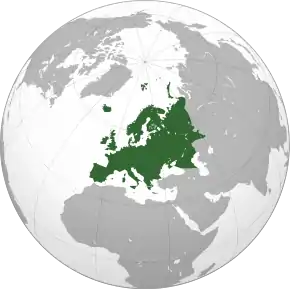Nena (supercontinent)
Nena, an acronym for Northern Europe–North America, was the Early Proterozoic amalgamation of Baltica and Laurentia into a single "cratonic landmass", a name first proposed in 1990.[1] Since then several similar Proterozoic supercontinents have been proposed, including Nuna and Arctica, that include other Archaean cratons, such as Siberia and East Antarctica.[2]
In the original concept Nena formed c. 1,900 million years ago in the Penokean, Makkovikan, Ketilidian, and Svecofennian orogenies.[3] However, because Nena excludes several known Archaean cratons, including those in India and Australia, it is strictly speaking not a supercontinent. Nena, or Nuna, can, nevertheless be thought of as the core of Columbia, another supercontinent concept with several proposed configurations.[2]
Nena as a continent has been associated with the Sudbury Basin Impact.
References
- Notes
- Gower, Ryan & Rivers 1990, Introduction, p. 2
- Meert 2012, pp. 990–991; Figg. 5-6, pp. 990–991
- Gower, Ryan & Rivers 1990, Abstract
- Sources
- Gower, C. F.; Ryan, A. B.; Rivers, T. (1990). "Mid-Proterozoic Laurentia–Baltica: an overview of its geological evolution and a summary of the contributions made by this volume". In Gower, C. F.; Rivers, T.; Ryan, B. (eds.). Mid-Proterozoic Laurentia-Baltica (PDF). St. John's Newfoundland: Geological Association of Canada. pp. 1–20. Retrieved 1 April 2018.CS1 maint: ref=harv (link)
- Meert, J. G. (2012). "What's in a name? The Columbia (Paleopangaea/Nuna) supercontinent" (PDF). Gondwana Research. 21 (4): 987–993. doi:10.1016/j.gr.2011.12.002. Retrieved 1 April 2018.CS1 maint: ref=harv (link)
.svg.png.webp)
.svg.png.webp)
.svg.png.webp)
.svg.png.webp)


.svg.png.webp)
_political.svg.png.webp)
.svg.png.webp)
.svg.png.webp)
.svg.png.webp)